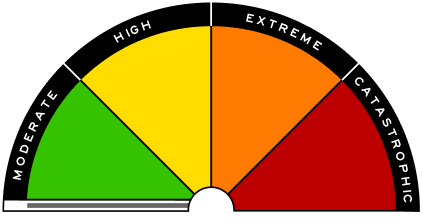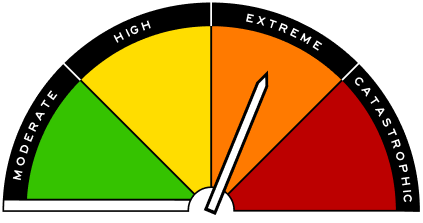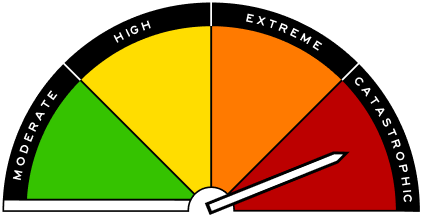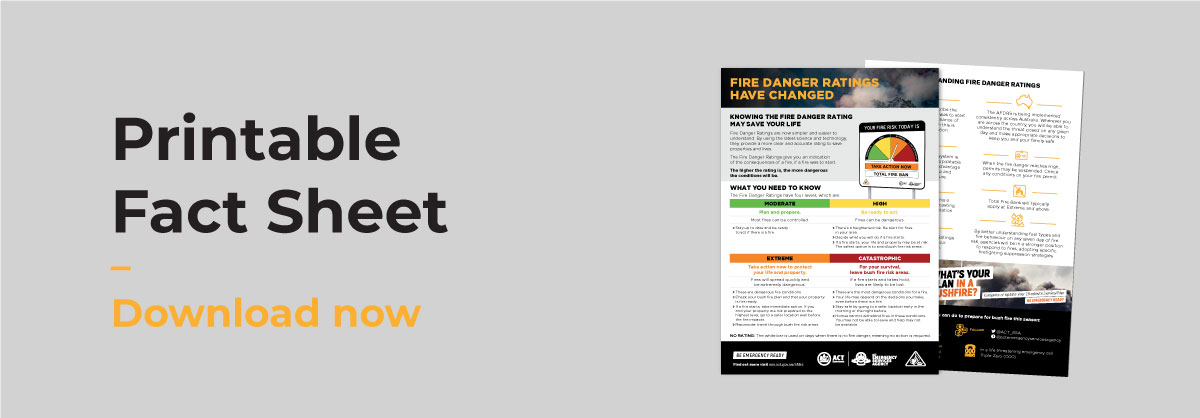Australian Fire Danger Rating System (AFDRS)
On the 1 September 2022, Australia’s Fire Danger Rating System was improved and simplified, to make it easier for you to make decisions to stay safe on days of fire danger risk. The move to a simplified system is backed by improvements in science, which will mean we can better predict areas of greater risk on days of fire danger. Across the country fire and emergency services are applying nationally consistent colours, signs and terminology. This means that wherever you go in Australia, and whatever the season or fuels you’re surrounded with, you can understand the level of threat and what you need to do to stay safe.
The AFDRS will implement a new public-facing design for fire danger ratings that will improve public awareness of fire danger and guide members of the community to appropriate action to reduce their risk of bushfire exposure. A new set of high-level calls to action and secondary messaging has been agreed to, to ensure a nationally consistent understanding of the level of risk faced on any given day.
The new Australian Fire Danger Rating (AFDRS) levels are: MODERATE HIGH EXTREME CATASTROPHIC.
The AFDRS will also introduce a “no rating” for those days where no proactive action is required by the community. On these days, you will still need to abide by local seasonal laws and regulations, such as TOBANs, but there is little risk of a fire spreading in a dangerous or life-threatening way.

Changing the Science:
- The current Fire Danger Rating System is largely based on science that is more than 60 years old. New technology and research have greatly improved our ability to accurately predict fire behaviour and the potential threat to the community.
- The AFDRS uses the latest scientific understanding about weather, fuel and how fire behaves in different types of vegetation to improve the reliability of fire danger forecasts. This strengthens the ability of those working in emergency services to be better prepared, make improved decisions, and provide better advice to the community.
- The new fire danger rating system is designed to be continuously updatable so that the system can take advantage of improving science, data and information into the future.
- By better understanding fuel types and fire behaviour on any given day of fire risk, agencies will be in a stronger position to respond to fires, adopting specific firefighting suppression strategies.
- Because the AFDRS makes better fire danger predictions; government, the community and industry can have greater confidence in the information and advice provided.
Frequently Asked Questions
Extensive social research found that most people in bushfire risk areas don’t understand the current system. There were calls for a simpler, action-oriented system.
The science that sits behind Fire Danger Rating modelling is being improved. A better understanding of how different fuel types burn and improvements in technology means we can more accurately predict the risk faced by communities on any given day.
Industries and members of the community who need more information will be able to access the Fire Behaviour Index, which will give a more in-depth level of detail about the fire danger.
Community research found that most people were familiar with the old system, it just seemed too technical and irrelevant for them. We have made significant changes to how we calculate fire danger risk, so that the ratings and information provided to the community is more accurate.
The AFDRS is being coordinated by NSW RFS and AFAC (the National Council for Fire and Emergency Services), with support from the Bureau of Meteorology. A National Program Board, with representation from each of the State and Territories’ fire agencies are overseeing the program, which is being delivered by local implementation teams.
click the below links to see a list of printable fact sheets in each language.









